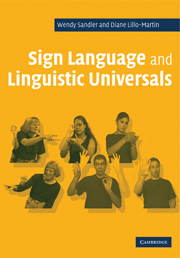Book contents
- Frontmatter
- Contents
- Preface
- Notation conventions
- UNIT I INTRODUCTION
- UNIT II MORPHOLOGY
- UNIT III PHONOLOGY
- UNIT IV SYNTAX
- 17 Syntax: introduction
- 18 Clausal structure
- 19 Clausal structure across sign languages
- 20 Variations and extensions on basic sentence structures
- 21 Pronouns
- 22 Topic and focus
- 23 WH-questions
- 24 Syntax: summary and directions
- UNIT V MODALITY
- References
- Index
20 - Variations and extensions on basic sentence structures
Published online by Cambridge University Press: 05 June 2012
- Frontmatter
- Contents
- Preface
- Notation conventions
- UNIT I INTRODUCTION
- UNIT II MORPHOLOGY
- UNIT III PHONOLOGY
- UNIT IV SYNTAX
- 17 Syntax: introduction
- 18 Clausal structure
- 19 Clausal structure across sign languages
- 20 Variations and extensions on basic sentence structures
- 21 Pronouns
- 22 Topic and focus
- 23 WH-questions
- 24 Syntax: summary and directions
- UNIT V MODALITY
- References
- Index
Summary
We have seen how basic sentences are structured in ASL (Chapter 18) and LSB (Chapter 19). We turn now to the structures associated with additional sentence types. What these sentence types have in common is that they all may involve functional categories – those categories other than the lexical categories, N, V, A, P. Functional categories (such as Determiner, Agreement, Aspect, Negation, and Tense) may host lexical items (words or affixes) in their heads, but in some cases they are postulated to host only features. In either case, the presence of a functional category will often have an effect on some other part of the structure – for example, by requiring movement of some other element to its specifier. The element in the head of a functional category and the element in its specifier “agree” through “spec–head agreement.” This process is used in accounting for a number of phenomena. For example, we have already seen that the subject of a sentence may appear in [Spec, TP]. If the verb moves (through Agr) to T, then the subject and verb will check each other's features, so that subject–verb agreement is obtained.
It has been proposed that it is in functional categories where the differences between languages are coded (Borer 1983, Chomsky 1993, but see Snyder 2001 for support of the view that not all cross-linguistic parametric differences are associated with functional categories).
- Type
- Chapter
- Information
- Sign Language and Linguistic Universals , pp. 334 - 368Publisher: Cambridge University PressPrint publication year: 2006



